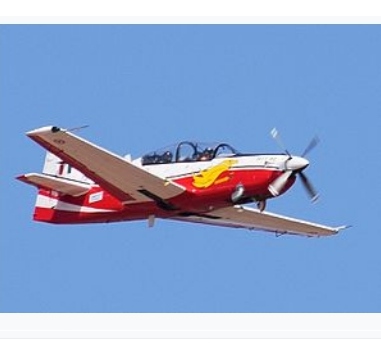HTT-40 Trainer Aircraft To finally join the IAF

When the IAF ‘S basic trainer the HPT32 started getting old,the Aircraft Research and Design Centre of HAL began developing the Basic Trainer Aircraft (HTT-40) Prototypes. The Unit cost was likely to be Rs 35 crores.
The HTT-40 project was conceptualised by HAL to fulfil the IAF’s requirement of 181 trainer aircraft. The primary role was to be basic flight training, aerobatics, instrument flying and close-formation flights, whereas its secondary roles was to include navigation and night-flying.
The HTT-40 was going to be an all-metal tandem seat aircraft powered by a 1,100 hp (820 kW) turboprop engine. HAL chose the Honeywell Garrett TPE331-12B turboprop to power the trainer.
However due to the HTT-40’s development delays and sudden grounding of HPT32 after a fatal crash,MoD placed an urgent order in May 2012 for 75 Pilatus PC-7 Mk II turboprop trainers to meet the urgent operational training requirements of the IAF.
HAL Slowly completed works on ground test of air-frame and also produced several air-frame structures for the first aircraft by mid-2015. The aircraft was then projected to enter production by 2018. The serial production was to start at HAL’s transport aircraft division (TAD) in Kanpur.

Finally two prototypes were developed and the first flight took place on 31 May 2016. The flight lasted for about 30 minutes. The pilot carried out circuits and the aircraft performance was satisfactory.
The HTT-40 was now a fixed-wing aircraft incorporating an all-metal airframe design. It featured a bubble canopy, T-tail configuration and a retractable tricycle landing gear system with a steerable nose wheel.
On 19 May 2017, the second prototype completed its maiden flight. On 10 November 2018, HTT-40 started its spin test by successfully entering into two-turn spin and subsequently recovering with the appropriate controls.
According to HAL, the spin testing is the most crucial and challenging aspect of flight testing of any aircraft development programme. Arup Chatterjee, Director (Engineering and R&D) said the spin completion was the last metric which needed to be accomplished before the aircraft entered service.
On 6 September 2019 HTT-40 completed a five spin trial successfully and on 7 September 2019 it successfully completed a six spin trial. A HAL official had said that if all goes right than it will get IOC (Initial operational clearance) by end of 2019 and after placement of order 1st aircraft will be handed over to IAF within 1 year.
Last November, in a show of faith the chief of the Indian Air Force (IAF) ACM RKS Bhadauria had taken the second prototype of HTT-40 basic trainer aircraft (TSR002) for a spin. In the flight which had lasted for almost one hour, the chief who was accompanied by the HAL’s chief test pilot Gp Capt (Retd) KK Venugopal had assessed not only the stall and spin but also other flying characteristics of the aircraft.
In a span of five years, the HTT-40 has so far completed all the major spin tests.

HAL was now looking for LSP (limited series production) to start by 2020.
On 11 August 2020, the Defence Acquisition Council has at last approved procuring 106 HTT-40s for the Indian Air Force, an order worth ₹8,722.38 crore (approx US$1.1688B).
It has a maximum take-off weight of 2,800kg and can be configured to carry a gun, rockets and bombs to perform light combat and counter-insurgency missions.
The air-conditioned, glass cockpit accommodates two crew, including an instructor and trainee in tandem seating configuration with zero-zero ejection seats. It integrates multi-function displays, and modern navigation and communication systems.
General characteristics

Crew: 2
Length: 10.5 m (34 ft 5.5 in)
Wingspan: 11 m (36 ft 1 in)
Height: 3.4 m (11 ft 1.75 in)
Gross weight: 2,800 kg (6,173 lb)
Fuel capacity: 450 kg
Powerplant: 1 × Honeywell Garrett TPE331-12B turboprop, 834 kW (1,100 shp) derated to 708 kW (950 shp)
Propellers: 4-bladed
Performance
Maximum speed: 400 km/h (249 mph, 216 kn)
Never exceed speed: 450 km/h (279 mph, 243 kn)
Range: 1,000 km (621 mi, 540 nmi)
Service ceiling: 6,000 m (19,680 ft)
g limits: +6/-3
MAXIMUM TAKE-OFF WEIGHT
2,800kg
The TPE331-12B turboprop engine, equipped with full-authority digital engine control (FADEC) system, develops a maximum power output of 950 shaft horsepower (shp).
It is one of the most widely-employed turboprop power-plants in operation. It enables the HTT-40 to offer users quick acceleration, low-fuel consumption, high-reliability and the flexibility to conduct a range of training missions. The reliable turboprop engine also allows HAL to develop a range of variants that will deliver increased levels of performance.
The HTT-40 trainer offers the best-in-class fuel economy and power rating. It takes-off from a short distance and has a high rate of climb. It has a maximum speed of 450km/h and can reach a maximum distance of 1,000km. The stall speed with flaps down is 135km/h.
The certified operational ceiling of the trainer is 6,000m, the ‘G’ limits are +6/-3 and airborne endurance is three hours.
So now IAF will get an indigenous aircraft basic stage training. HAL should now concentrate on HJT36 as replacement of Kiran Mk2.

The HTT-40 is powered by Honeywell TPE331 series engine.
The HTT-40 (Hindustan Turbo Trainer-40) basic training aircraft will enter service with the Indian Air Force. Image courtesy of Anirvan Shukla.
The basic training aircraft is being developed indigenously by state-owned Hindustan Aeronautics Limited (HAL). Image courtesy of Mi
The HTT-40 is powered by Honeywell TPE331 series engine. Image courtesy of.
The HTT-40 (Hindustan Turbo Trainer-40) basic training aircraft will enter service with the Indian Air Force.




